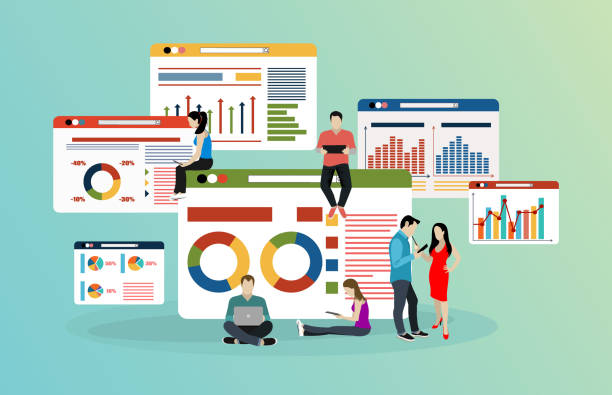Introduction to Modern UI Website Design

#Introduction #Web_Design #User_Interface #User_Experience
In today’s world, websites are no longer merely collections of informational pages; they have transformed into powerful tools for interaction, audience engagement, and service delivery.
With technological advancements and increasing user expectations, modern user interface website design is no longer a luxury choice but an undeniable necessity.
This approach goes beyond mere visual aesthetics, focusing on creating a seamless, enjoyable, and efficient experience for the user.
A website with a modern user interface must be both visually appealing and functionally flawless.
This means everything from color schemes and fonts to element layout and responsiveness must be designed in a way that allows users to easily interact with it and achieve their goals.
Modern design is more than just a beautiful appearance; it’s a philosophy that prioritizes the ultimate user experience, ensuring that every visitor navigates the site smoothly and purposefully.
The main goal in modern UI website design is not only to capture the user’s attention at first glance but also to retain them and encourage their return.
This is achieved by deeply understanding user needs and behaviors, then designing an intuitive and pleasant path for them.
Novel UI design includes the use of subtle animations, micro-interactions, simple and understandable navigation systems, and efficient input forms.
These elements together provide an experience beyond user expectations.
In fact, every element in the design must be purposeful and contribute to improving the overall user experience, including reducing cognitive load and increasing efficiency.
This approach ensures that the website is not only efficient but also conveys a good feeling to the user and remains memorable in their mind, which in turn leads to customer loyalty.
Modernizing the user interface also means adapting to different devices.
A website design should be such that it appears equally efficient and beautiful on all platforms, from desktop to tablet and smartphone.
This feature, known as responsive design, is an inseparable principle of modern UI website design.
Its importance lies in the fact that today’s users utilize a wide range of devices, and an inconsistent experience can quickly discourage them.
By focusing on these principles and leveraging the latest development techniques, one can ensure that the website remains relevant and attractive not only in the present but also in the future, exceeding user expectations.
This approach is the foundation of success in the digital space.
Does your current e-commerce website design not generate the expected sales for you?
RasaWeb specializes in professional e-commerce website design!
✅ An attractive and user-friendly website aimed at increasing sales
✅ High speed and security for an ideal shopping experience⚡ Get a free consultation for online store design with RasaWeb!
Why is Modern UI Design Crucial?

#Importance #Competition #Marketing #Branding
In today’s competitive digital market, simply having a website is not enough; your website must create a competitive advantage.
This is where modern UI website design plays its vital role.
A website with an outdated or unsuitable UI/UX can quickly drive users away and even harm brand credibility.
On the other hand, a modern and user-friendly design not only attracts users but also encourages them to stay and interact more with the site.
This directly impacts the conversion rate, sales increase, and customer loyalty.
Today’s users are more impatient than ever, and if they encounter any obstacle or confusion, they will quickly move on to your competitors.
This intense online competition doubles the importance of investing in a flawless user experience.
Numerous studies on web user behavior have shown that most people decide whether to stay on a website within the first few seconds of entering it.
This short time is a golden opportunity that modern UI website design can manage in the best possible way.
Attractive visual design, easy navigation, and fast performance are key factors in creating a positive first impression.
Furthermore, a modern and smooth user interface conveys a sense of professionalism and up-to-dateness to the audience, which significantly helps strengthen your branding.
A well-designed website not only demonstrates your attention to detail but also reflects your importance to user experience, which leads to trust-building and ultimately increased customer loyalty.
Beyond customer acquisition and retention, advanced UI design also improves search engine optimization (SEO).
Search engines like Google consider factors such as user dwell time on the site, bounce rate, and page loading speed in website rankings.
A website with modern UI website design naturally performs better on these metrics because users enjoy browsing it and are less inclined to leave the page quickly.
Therefore, investing in modern design is a smart and vital investment in the future of your business, not only helping attract users but also leading to sustainable growth and maintaining your competitive position in the digital market.
This is a long-term strategy for success.
Key Principles in Modern UI Design

#Design_Principles #UI/UX #User-Friendly #Minimalism
To achieve a modern UI website design, one must adhere to specific principles and rules.
These principles not only contribute to visual appeal but also guarantee the website’s efficiency and user-friendliness.
The first and most important principle is simplicity and minimalism.
Removing unnecessary elements and focusing on what truly matters helps the user achieve their goal without confusion.
A cluttered and information-heavy design creates an unpleasant experience for the user and quickly tires them out.
Instead, make good use of whitespace to make important elements more visible and improve readability.
This approach ensures that information is presented in a structured and digestible manner.
The second principle is consistency and uniformity.
All visual elements, including colors, fonts, icons, and how buttons interact, must be consistent throughout the website.
This uniformity helps the user quickly learn navigation patterns and feel familiar with the environment.
For example, if a button on one page is blue and has a specific function, it should appear with the same color and function on other pages.
This consistency increases user trust in the system and reduces their cognitive load, as they don’t need to encounter a new user interface every time.
Nielsen’s Usability Heuristics are a good guide in this regard and emphasize the importance of consistency.
The third principle is Responsiveness.
As mentioned earlier, the website must be displayed correctly and function properly on all devices and screen sizes, from desktop to mobile.
This feature ensures that no user will have an inappropriate experience due to their device type.
Advanced UI design also emphasizes Accessibility for all users, including those with disabilities.
Using appropriate color contrast, alternative text for images, and keyboard navigation are among the points that should be considered.
Finally, visual and interactive feedback to the user regarding their actions, such as changing a button’s color after clicking or displaying a success message, conveys a sense of control and assurance, which is a vital part of an enjoyable user experience.
| Principle | Explanation | Practical Example |
|---|---|---|
| Simplicity and Minimalism | Eliminating clutter and focusing on essential elements to reduce user confusion and improve focus. | Extensive use of whitespace, simple navigation with minimal options, limited number of fonts and colors. |
| Consistency and Uniformity | Standardizing elements and interactive patterns throughout the website to create a sense of familiarity. | Keeping button colors and appearance, heading fonts and sizes, and logo placement consistent across all pages. |
| Responsiveness | Designing for correct display and functionality on all devices and screen sizes, including mobile and tablet. | Fluid layout, flexible images that adapt to screen size, mobile-specific dropdown menus. |
| Accessibility | Designing for easy use by individuals with diverse abilities, including people with disabilities. | High color contrast between text and background, descriptive alternative text (alt text) for images, full keyboard navigation capability. |
| Feedback and Interaction | Providing visual and textual responses to user actions to inform and create a sense of control. | Button state change after clicking (e.g., pressed or color change), clear success/error messages, loading animations to indicate processing. |
Tools and Technologies in Modern Web Design

#Design_Tools #Web_Technologies #UI/UX_Tools #Front_End
Achieving a modern UI website design requires the use of advanced tools and technologies that enable the implementation of new creativity and ideas.
In the field of UI/UX design, various software applications help designers implement their designs in the best possible way.
Adobe XD, Figma, and Sketch are among the most popular UI design tools, offering features such as wireframing, prototyping (creating interactive models of designs), and team collaboration.
Figma, in particular, has become very popular in recent years due to its online collaborative capabilities and high speed.
These tools allow for pixel-perfect design and simulation of the actual user experience, significantly increasing the speed of the design process.
In frontend development, which is responsible for converting graphic designs into executable code in the browser, powerful technologies play a fundamental role in achieving modern design.
HTML5 and CSS3 form the foundation of any website, providing extensive capabilities for responsive design and attractive animations with their new features.
To add interaction and dynamism to the website, JavaScript and its powerful frameworks like React.js, Vue.js, and Angular play a vital role.
These frameworks enable the development of complex single-page applications (SPAs) with high performance and smooth user experience.
Using these tools and frameworks in modern UI website design, helps development teams create complex and interactive websites quickly and with high quality, while also making code maintenance easier.
Furthermore, Content Management Systems (CMS) like WordPress, Joomla, and Drupal, by offering modern and flexible themes and plugins, enable the implementation of advanced designs without the need for deep coding.
These CMSs are particularly useful for small and medium-sized businesses that need to launch a website quickly.
CSS libraries like Bootstrap and Tailwind CSS also help designers and developers quickly create beautiful user interfaces while adhering to modern design standards.
These tools, by providing ready-made patterns and grid systems, accelerate and facilitate the process of advanced UI design.
The correct selection of these tools and technologies will play a significant role in the final quality, efficiency, and scalability of the website, helping to achieve business goals.
Are you frustrated with your online store’s low conversion rate?
RasaWeb, with professional e-commerce website design, is your definitive solution!
✅ Increase your sales and revenue
✅ Unparalleled user experience for your customers
⚡ Get a free consultation now!
User Research and Empathy in UI/UX Design

#User_Research #Empathy #Customer_Journey_Map #Persona
The foundation of any modern UI website design is a deep understanding of users.
Without comprehending the needs, goals, and challenges of the audience, any effort in UI design will be mere guesswork, which can lead to project failure.
User research plays a pivotal role in this process and is recognized as the first step in any successful design project.
This research includes various methods such as user interviews, surveys, competitor analysis, and observing user behavior on similar websites.
The main objective of this phase is to collect qualitative and quantitative data to create a comprehensive and realistic understanding of those who will use the website.
This data helps the design team make more informed decisions regarding the site’s layout, navigation, and content, and from the outset, base the design on real needs.
One of the most important outputs of user research is the creation of User Personas.
Personas are fictional characters defined based on real user data, reflecting characteristics such as age, occupation, interests, goals, and pain points of target users.
By having personas, the design team can put themselves in the users’ shoes and, with empathy, view problems from their perspective and provide appropriate solutions.
This empathetic approach helps the design deliver real and effective solutions for user needs and prevents major mistakes.
For example, if the persona indicates that your users have difficulty with long forms, your modern UI website design should include shorter, multi-step forms or use auto-completion to provide a better user experience.
In addition to personas, creating a Customer Journey Map is also a powerful tool.
This map tracks all user touchpoints with the website from entry to performing a specific action (e.g., purchase or registration) and illustrates the user’s emotions and experiences at each stage.
By identifying strengths and weaknesses in this journey, opportunities for improving the user experience and, consequently, advanced UI design can be identified, and targeted optimizations can be made.
This continuous process of research, empathy, and testing ensures that the website always moves in the right direction and meets the evolving needs of users.
The more accurate and deeper your information about your users, the more effective and successful your design will be, significantly assisting your business.
The Role of Accessibility in Modern Design

#Accessibility #Web_Accessibility #WCAG #Inclusive_Design
In today’s world, modern UI website design is no longer limited to just aesthetics and functionality; it must also include Accessibility.
Accessibility means designing a website in such a way that individuals with disabilities (such as visual, auditory, motor, or cognitive impairments) can easily use it and access its information and services.
This is an ethical and humanitarian principle that contributes to social justice in the digital space, but in many countries, there are also specific laws that oblige organizations to comply with web accessibility standards.
Ignoring this aspect can lead to losing a large segment of the audience and even legal consequences, harming business credibility.
The W3C organization has defined standards called Web Content Accessibility Guidelines (WCAG), which have four general principles: Perceivable, Operable, Understandable, and Robust.
These principles provide practical and precise guidance for developers and designers to ensure that websites are accessible to all users.
For example, using alt text for images helps users with visual impairments who use screen readers to understand the content of images.
Also, providing captions for videos helps individuals with hearing impairments follow the content, ensuring no one is deprived of information.
The good news is that many techniques related to modern UI website design, naturally overlap with accessibility principles.
For instance, simple and minimalist design, clear navigation, and appropriate color contrast not only improve the user experience for the general public but also benefit individuals with disabilities, making the site easier for them to use.
Inclusive Design, which aims to create products for a wider range of users, is at the heart of the modern UI/UX approach and emphasizes the importance of considering all users.
By adhering to these principles, we not only help society but also expand our audience and create a website that is truly for everyone.
An advanced UI design always considers accessibility as a primary priority and deems it an inseparable part of website quality.
Future Trends in UI/UX Design

#Future_Trends #UI/UX_Trends #Artificial_Intelligence #Virtual_Reality
The world of modern UI website design is rapidly evolving, and every day we witness the emergence of new trends that are revolutionizing user experience.
These advancements not only make design more engaging but also elevate efficiency and personalization to new levels.
One of the most significant of these trends is the integration of Artificial Intelligence (AI) and Machine Learning (ML) into user interface design.
AI can analyze user behavior to create personalized and adaptive user interfaces that dynamically respond to each user’s individual needs.
For example, smart chatbots and voice assistants (Voice UI) that offer a more natural interaction experience with websites are instances of this integration.
These technologies allow websites to intelligently respond to user needs and provide relevant and helpful suggestions, leading to increased user satisfaction and engagement.
Other trends include Virtual Reality (VR) and Augmented Reality (AR), which have great potential for creating immersive and interactive web experiences.
Although still in their early stages and mostly used in specific domains like gaming and education, it is expected that in the near future, we will see websites utilizing these technologies to present products in entirely new ways (e.g., virtually trying on clothes or home decor before purchasing).
3D design and advanced motion graphics are also increasingly gaining popularity, adding more depth and visual appeal to websites.
These elements not only make the website more beautiful but can also convey complex messages in an entertaining and understandable manner, enriching the user experience.
Furthermore, design for Web 3.0 and the Metaverse is also taking shape.
These trends signify a focus on decentralized experiences, digital ownership, and blockchain-based interactions, which demand new approaches in modern UI/UX website design.
Content-first design, where content is central to the design and the user interface intelligently shapes around it, is also a growing trend.
This approach ensures that content is easily accessible and consumable.
Additionally, there is an increasing focus on Inclusive UX, which emphasizes that design should be suitable for everyone, regardless of their abilities or circumstances.
These developments indicate that advanced UI design is constantly evolving, and designers must continuously stay updated and adapt to these changes to create unparalleled user experiences.
| Trend | Description | Potential Web Application |
|---|---|---|
| Integration of AI and Machine Learning | Creating personalized and intelligent experiences based on user behavior and preferences to improve interaction. | Advanced and responsive chatbots, efficient voice assistants, smart and personalized content and product recommendations. |
| Virtual Reality (VR) and Augmented Reality (AR) | Providing immersive and interactive experiences beyond the 2D screen, with the ability to simulate the real world. | Virtual display of products in the user’s environment (e.g., furniture in a home), virtual tours of places and spaces, interactive training. |
| 3D Design and Motion Graphics | Adding visual depth, dynamism, and appeal to the user interface, using animated and 3D elements. | Complex and fluid animations for information transfer, interactive 3D icons, animated and rotatable product models. |
| Design for Web 3.0 and the Metaverse | Focusing on decentralization, digital ownership, and blockchain-based interactions. | Integrated digital wallets on websites, displaying and managing Non-Fungible Tokens (NFTs) in the web space, virtual social experiences within the browser. |
| Inclusive User Experience (Inclusive UX) | Designing to ensure easy access and use for all users, regardless of abilities, language, or culture. | Special attention to accessibility for people with disabilities (WCAG), designing for cultural and linguistic differences, offering personalization options for users. |
Common Mistakes in UI/UX Design and Solutions to Avoid Them

#Design_Mistakes #UX_Improvement #User_Testing #Iterative_Design
Even with the best intentions and technical knowledge, mistakes can occur in modern UI website design that harm the user experience and even lead to customer loss.
Identifying and avoiding these mistakes is crucial for creating a successful and sustainable website.
One of the common and important mistakes is ignoring user research.
Without a real and deep understanding of the audience, your design might look beautiful but fail to address the actual needs, expectations, and challenges of users.
The solution is to dedicate sufficient time to researching and collecting data from target users before starting the design, and continuously receive and apply user feedback throughout the process.
This data-driven approach ensures that the design is based on realities.
Another mistake is over-complicating the user interface.
Sometimes designers try to impress users by adding too many features and elements, thinking that more functionality is better, but the result is a cluttered, confusing, and difficult-to-use website.
The solution is to adhere to the principle of minimalism and place each element on the page with a specific purpose.
Ask whether this element is truly essential for the user and if it helps achieve the site’s main goal.
Advanced UI design emphasizes simplicity, efficiency, and intuitiveness.
Also, disregarding responsiveness is another major mistake.
In today’s world, where users access websites from various devices, failure to optimize for mobile and tablet can lead to losing a large portion of traffic and users.
Always test your design across different screen sizes and ensure correct display and smooth performance on all devices.
Other common mistakes include lack of appropriate user feedback (e.g., not displaying a success message after form submission or not showing loading status), using unsuitable fonts and colors (which reduce readability and can cause eye strain), and illogical and complex navigation (which confuses the user and prevents them from reaching their destination).
To avoid these, use Usability Testing with real users.
These tests can reveal hidden weaknesses in your design and indicate opportunities for improvement.
Iterative Design, which involves continuous improvement based on feedback and data, is key to achieving a flawless modern UI/UX website.
Remember that design is an ongoing process, not a one-time project that ends after launch; it always requires monitoring and optimization.
Did you know a weak corporate website loses you many opportunities daily? Solve this problem forever with professional corporate website design by RasaWeb!
✅ Create a powerful and trustworthy image for your brand
✅ Targeted attraction of new customers and increased sales
⚡ [Get free website design consultation]
Measuring Success in Modern UI/UX Design

#Success_Metrics #Web_Analytics #Conversion_Rate #Customer_Satisfaction
After implementing a modern UI website design, it’s important to be able to measure its success quantitatively and qualitatively.
Merely “looking beautiful” is not enough”; we must ensure that the design responds to business goals and user needs, and yields tangible results.
Web analytics is a powerful tool for collecting data related to user behavior, providing valuable insights.
Metrics such as Bounce Rate, which indicates the percentage of users who visit only one page and leave the site, Dwell Time, which is the average time users spend on the website, and number of pages visited per session, offer important insights into the level of user engagement with the website.
A high bounce rate or low dwell time can indicate problems in the user interface or content that require careful review and improvement.
One of the most important success metrics in UI/UX design is the Conversion Rate.
This rate indicates the percentage of visitors who perform a desired and predefined action, such as purchasing a product, subscribing to a newsletter, filling out a contact form, or downloading a file.
An advanced UI design should make the user’s path to performing these actions as smooth, clear, and engaging as possible.
Increased conversion rate directly impacts business revenue and profitability and indicates the effectiveness of the design.
Tools like Google Analytics and Hotjar can help you track these metrics and identify areas for improvement.
Hotjar, especially with features like heatmaps (showing click and focus points of users) and user session recordings, provides a precise view of how users interact with your pages.
Beyond quantitative metrics, Customer Satisfaction is also an important and vital indicator that can be measured qualitatively.
This can be assessed through surveys, direct feedback, user experience ratings, and even analysis of social media comments.
Asking users if your website is easy to use? Did they achieve their goal? And how satisfied are they with their experience? Can provide valuable information that is not visible in quantitative data.
A/B testing is also an effective method for comparing different design versions and finding the best solution for performance improvement.
By continuously analyzing this data and making necessary changes, modern UI website design can be continuously improved, ensuring the achievement of business goals.
This data-driven and user-centric approach ensures that your design efforts are always directed towards achieving the best results.
The Impact of Modern UI/UX Design on Businesses

#Business_Impact #Return_on_Investment #Customer_Loyalty #Competitive_Advantage
One might ask whether a significant investment in modern UI website design truly yields returns for businesses. The answer is a definitive yes, and this investment is not only economically justified but also a strategic necessity.
A modern UI/UX website functions beyond a mere attractive storefront; it is a strategic and powerful tool for business growth and sustainability.
Imagine your website not only attracting new customers but also converting them into loyal patrons who consistently return to your business.
This is precisely what intelligent, user-centric design can deliver.
Can you calculate the cost of losing customers who abandon your site due to a poor user experience? These costs are often far greater than the initial investment in good design.
The impact of modern UI website design on businesses is observable in several areas, each contributing to the overall success of the company.
Firstly, increased sales and revenue through improved conversion rates.
When users can easily find your products or services, obtain necessary information, and complete the purchasing process simply, your sales naturally and significantly increase.
Secondly, reduced support costs and customer service expenses.
An intuitive, clear, and efficient user interface drastically reduces the need for users to contact support for clarifications or issues, as they can easily find answers to their questions on the site.
This translates to significant savings in company time and financial resources.
Thirdly, strengthening brand credibility and reputation.
A professionally designed, up-to-date, and modern website lends your business a credible, trustworthy, and leading image, which is highly valuable in today’s competitive market and distinguishes you from your competitors.
Fourthly, increased customer loyalty.
When users have an enjoyable, hassle-free, and efficient experience interacting with your website, they are more likely to return and become permanent customers.
This loyalty, in turn, leads to Word-of-Mouth Marketing, which is one of the most effective and low-cost methods of attracting new customers.
Fifth, attracting top talent.
Companies that prioritize design and user experience are often recognized as pioneers and innovators, which can help attract the best designers and developers to your team.
Do you want to have a business that is at its peak not only in terms of technology but also in human experience? Advanced UI design is not just a technical aspect, but a strategic investment for the bright future of your business.
This investment distinguishes you from your competitors and paves the way for sustainable success.
Frequently Asked Questions
| Row | Question | Answer |
|---|---|---|
| 1 | What is “Modern UI Website Design”? | It refers to designing a website that uses the latest trends and best practices in User Experience (UX) and User Interface (UI) to make user interaction simple, engaging, and efficient. |
| 2 | Why is a modern UI important for a website? | A modern UI increases user satisfaction, improves conversion rates, increases user dwell time on the site, and creates a professional and up-to-date brand image. |
| 3 | What are the key elements of a modern UI? | Key elements include simplicity and minimalism, responsiveness, use of whitespace, appealing typography, subtle animations, a suitable color palette, and intuitive navigation. |
| 4 | What role does responsiveness play in modern UI design? | Responsiveness ensures that the website displays correctly on every device (mobile, tablet, desktop) and provides a seamless user experience, which is essential for modern UI. |
| 5 | How important is typography in modern UI design? | Typography plays a very important role in readability, visual hierarchy, and brand visual identity. Modern fonts and their combinations can contribute to the overall beauty and attractiveness of the site. |
| 6 | How are animations and micro-interactions used in modern design? | Animations and micro-interactions are used to create visual feedback, guide the user, and add a sense of dynamism and appeal to the user interface, provided they are not excessive. |
| 7 | What is the role of User Experience (UX) in modern UI design? | UX is the foundation of modern UI. A modern design must first be functional, understandable, and enjoyable (UX) and then beautiful and attractive (UI). |
| 8 | What tools are used for modern UI design? | Tools like Figma, Adobe XD, Sketch, and InVision are used for design, and frameworks like React, Vue.js, or Angular are used for implementation. |
| 9 | How can overly complex design be avoided in modern UI? | By focusing on minimalism, removing unnecessary elements, extensive use of whitespace, and adhering to the “Less is More” principle. |
| 10 | What is the importance of user testing in modern UI design? | User testing ensures that the designed user interface is truly useful, understandable, and engaging for users, and potential issues are resolved before launch. |
And other advertising services of RasaWeb Advertising Agency:
Smart Website Development: A professional solution for online growth focusing on SEO-driven content strategy.
Smart Direct Marketing: Designed for businesses seeking to improve SEO ranking through custom programming.
Smart Sales Automation: A dedicated service for improving SEO ranking based on precise audience targeting.
Smart Advertising Campaign: A fast and efficient solution for customer behavior analysis focusing on intelligent data analysis.
Smart Data Analysis: A fast and efficient solution for digital branding focusing on attractive UI design.
And over hundreds of other services in internet advertising, advertising consultation, and organizational solutions.
Internet Advertising | Advertising Strategy | Advertorial
Resources
Modern UI Website Design
Future Web Development Trends
Journey to Unparalleled User Experience
Next-Gen Websites Guide
? For a powerful and lasting presence in the digital space, RasaWeb Afarin Digital Marketing Agency is always with your business, offering innovative solutions including fast and professional website design.
📍 Tehran, Mirdamad Street, next to Bank Markazi, Kazeroon Jonubi Alley, Ramin Alley, No. 6


